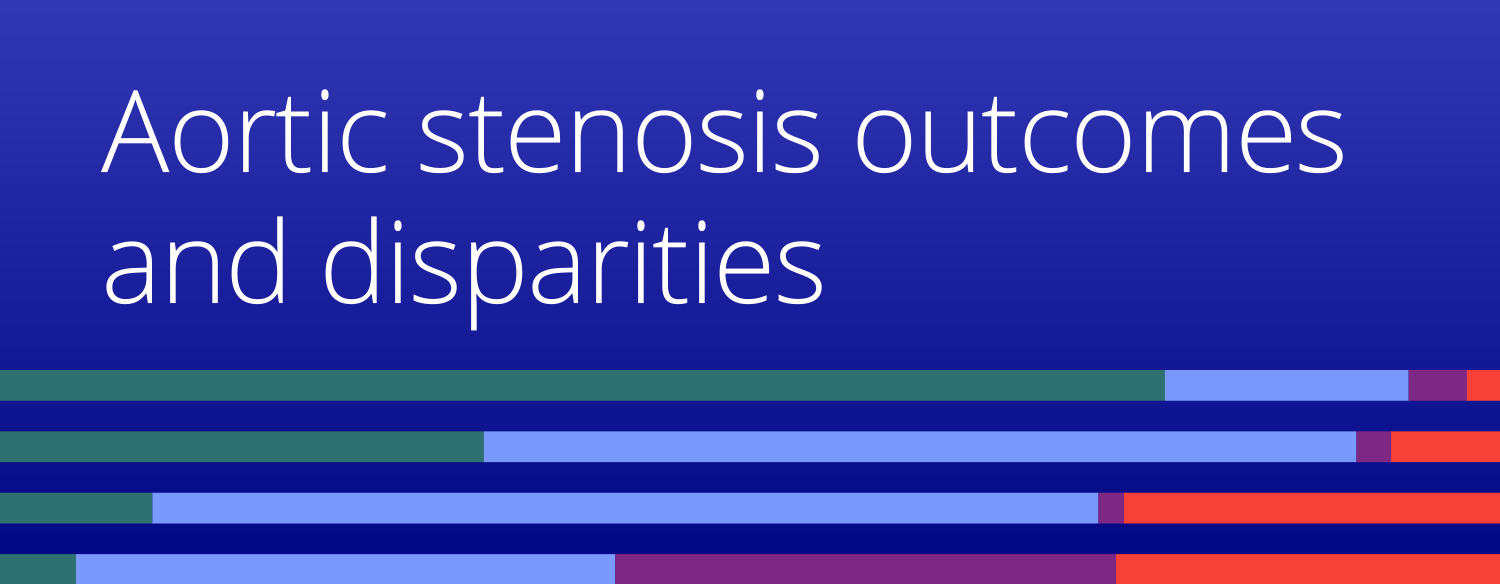- Disparities in time to treatment and treatment outcomes exist for people with severe aortic stenosis receiving TAVR and SAVR procedures. We studied the rate of people who receive TAVR, SAVR, aortic valve repair, and aortic balloon valvuloplasty procedures and time to procedures for patients receiving TAVR, by SDOH categories.
- Our analysis shows higher rates of TAVR procedures amongst older patients (aligning with AHA guidelines) and higher balloon valvuloplasty procedures for patients residing in rural areas, compared to urban areas.
- Unsurprisingly, we found decreased time between echocardiogram and TAVR procedure with increasing aortic stenosis severity. We also found decreased average time to TAVR for patients who live in an urban setting (compared to rural), for patients with increased individual income (amongst patients who made over US$35,000), and for patients with more familial support (measured by distance to closest relative).
Aortic stenosis severity is not often captured in structured EHR or claims data. We recently shared how we used extracted echocardiogram data from clinician notes, powered by the Truveta Language model, to identify people with different aortic stenosis severities and classify their disease progression.
Although we can classify this progression, we can also use these data to understand potential disparities in both the types of treatments provided and time to treatment. Procedures such as transcatheter aortic valve replacement (TAVR) and surgical aortic valve replacement (SAVR) have been shown to effectively reduce mortality in people with asymptomatic severe aortic stenosis (Ahmad et al., 2022) and moderate aortic stenosis (Franke et al., 2023), respectively. The number of TAVR and SAVR have increased in recent years (Bartus et al., 2019; Bevan et al., 2019). However, depending on the disease severity and symptoms, sometimes the risks outweigh the benefits of surgical outcomes and watchful waiting is the preferred method (Otto, 2006).
For a Medicare population, disparities in treatment rates exist for Black or African American (henceforth referred to as Black), Hispanic, Asian, and Alaska Native/American Indian patients with aortic stenosis, compared with white and non-Hispanic patients (Ahmed et al., 2023). Additionally, disparities in mortality outcomes for Black, non-Hispanic or Latino, and non-metropolitan populations following TAVR procedures have been seen (Ahmed et al., 2023; Bevan et al., 2019).
The objective of this study was to explore the potential disparities in the types of treatments and time to treatment for those with aortic stenosis. You can view the study in its entirety in Truveta Studio.
Methods
We identified people who had an echocardiogram with at least one of five hemodynamic values used to classify aortic stenosis: aortic maximum velocity, aortic mean pressure gradient, aortic valve area, left ventricular ejection fraction, and aortic stroke volume index. We identified if people had symptoms for heart failure (reduced or preserved ejection fraction), chest pain or shortness of breath caused by the heart (angina) and fainting or the feeling that one might faint caused by a drop in blood pressure or heart rate (syncope or presyncope) prior to the echocardiogram.
We then classified if each echocardiogram had evidence of aortic stenosis based on the hemodynamic values. If there was evidence of aortic stenosis, we used the hemodynamic values and symptom data to classify the severity of aortic stenosis. We describe the methods for this in more detail in our previous blog. In short, echocardiograms were classified as having one of eight aortic stenosis severities based on the 2020 AHA guidelines (Otto et al., 2021):
- Mild progressive aortic stenosis
- Moderate progressive aortic stenosis
- Asymptomatic severe aortic stenosis
- Very severe asymptomatic aortic stenosis
- Asymptomatic severe aortic stenosis with left ventricle (LV) systolic dysfunction
- Symptomatic severe high-gradient aortic stenosis
- Symptomatic severe low-flow, low-gradient aortic stenosis with reduced LVEF
- Symptomatic severe low-gradient aortic stenosis with normal LVEF or paradoxical low-flow severe aortic stenosis
The figure below gives a visual of how these data were classified into each aortic stenosis severity category.
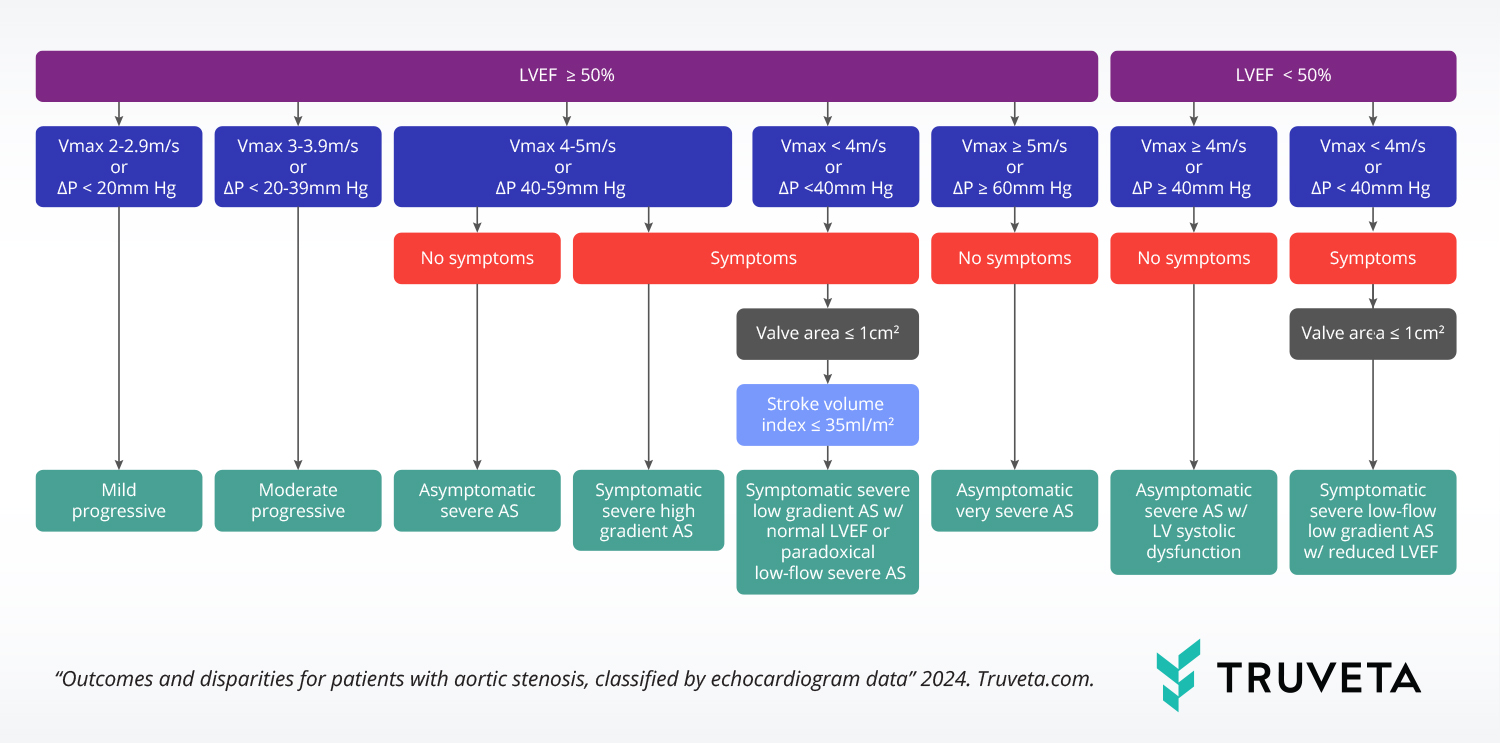
LVEF: left ventricle ejection fraction; Vmax: aortic maximum velocity; ΔP: aortic pressure gradient
For people with aortic stenosis, we then identified people who had a TAVR, balloon aortic valvuloplasty, SAVR, or aortic value repair procedure. SAVR procedures replace the aortic valve, through an open-heart surgery, while TAVR procedures are minimally invasive and use a catheter-based approach (Gleeson, 2018). Although TAVR procedures are recommended for people who cannot withstand open-heart surgery, not all patients are eligible (Gleeson, 2018).
We show differences in the demographics and social drivers of health (SDOH) for the population who received each procedure.
Time to procedures
We then calculated the time between the first echocardiogram indicating the current aortic stenosis severity and the subsequent procedure. We looked at differences by aortic stenosis severity, grouped into three categories: 1) mild or moderate progressive aortic stenosis, 2) asymptomatic severe or very severe aortic stenosis (referred to as asymptomatic severe), and 3) symptomatic aortic stenosis (inclusive of all symptomatic categories).
As the largest percentage of the population received TAVR procedures and they are indicated for people with severe aortic stenosis, we further subset of population to people with symptomatic severe aortic stenosis who received a TAVR procedure. We show differences in time to procedure for this population by SDOH fields. We focused on three primary SDOH fields for this analysis: individual income, rural or urban living, and family support (measured by distance to the closest relative). Rural or urban living was defined using the 3-digit zip code associated with the patient’s home, when available and mapped to HRSA rural zip codes (HRSA Health Resources & Services Administration, 2024).
Results
We included over 11,000 people with aortic stenosis and evidence of at least one procedure. Most people received TAVR procedures (67.8%) and fewer received SAVR (24.8%), aortic valve repairs (3.8%), and balloon valvuloplasty (3.6%).
The population was primarily over 65 years old (79.5%); however, there were differences in the rate of procedures for each age group. Over 77% of the population over 65 years old received a TAVR; this percentage decreased with each decreasing age group. The 18–44-year-old age group had the highest rate of SAVRs; the 45–64-year-old age group also had a higher rate of SAVRs, compared to the over 65-year-old population.
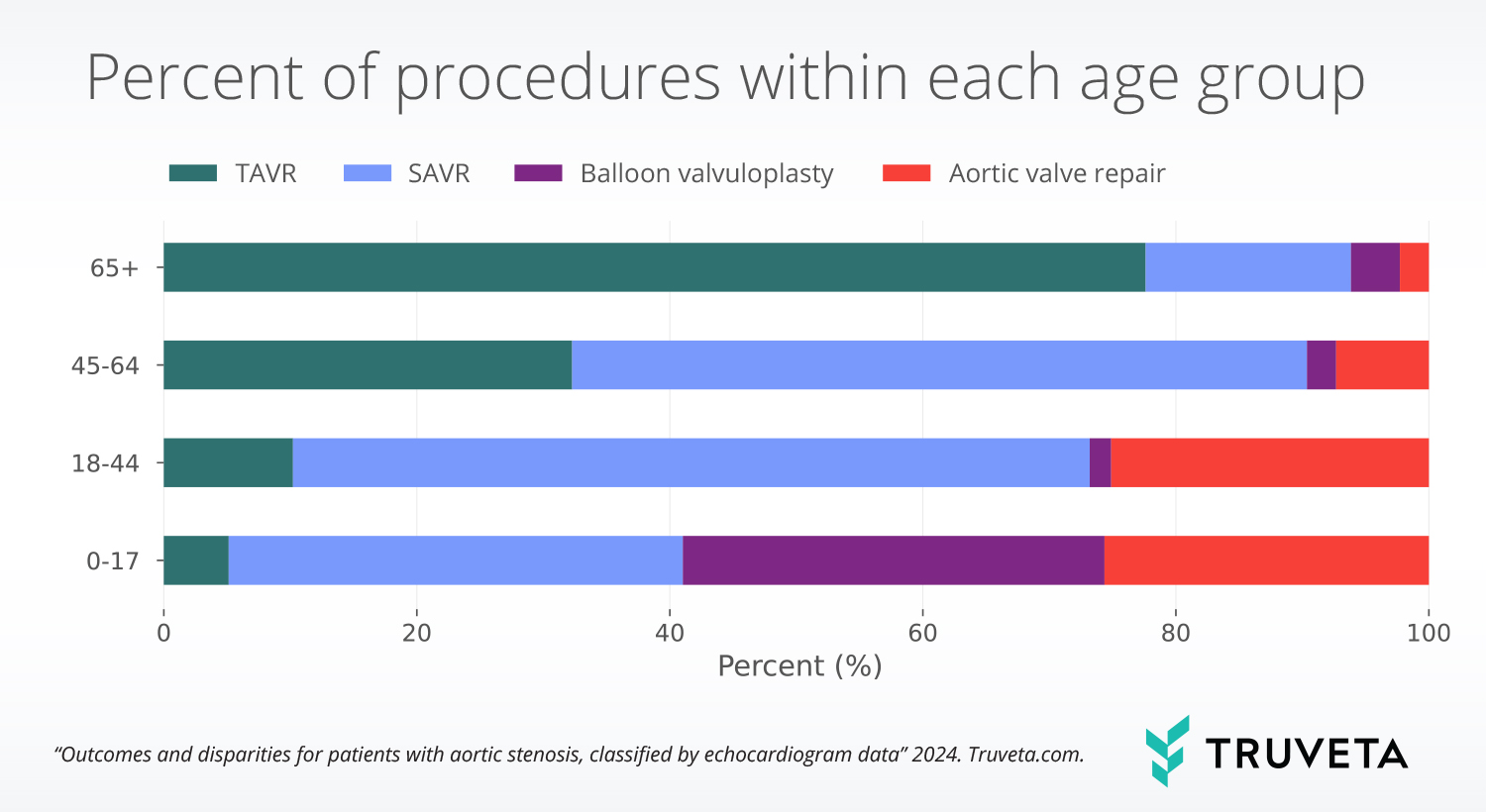
There was also variation by income group. There was a positive correlation between increased income and an increased rate of SAVRs; people in the lowest income group ($0-35,000) received SAVRs at 23.6% compared to people in the highest income group ($80,001+) who received them at 28.2%.
The opposite trend was seen for balloon valvuloplasty; people in the lowest income group received balloon valvuloplasty at higher rates (3.1%) compared to the highest income group (1.5%).
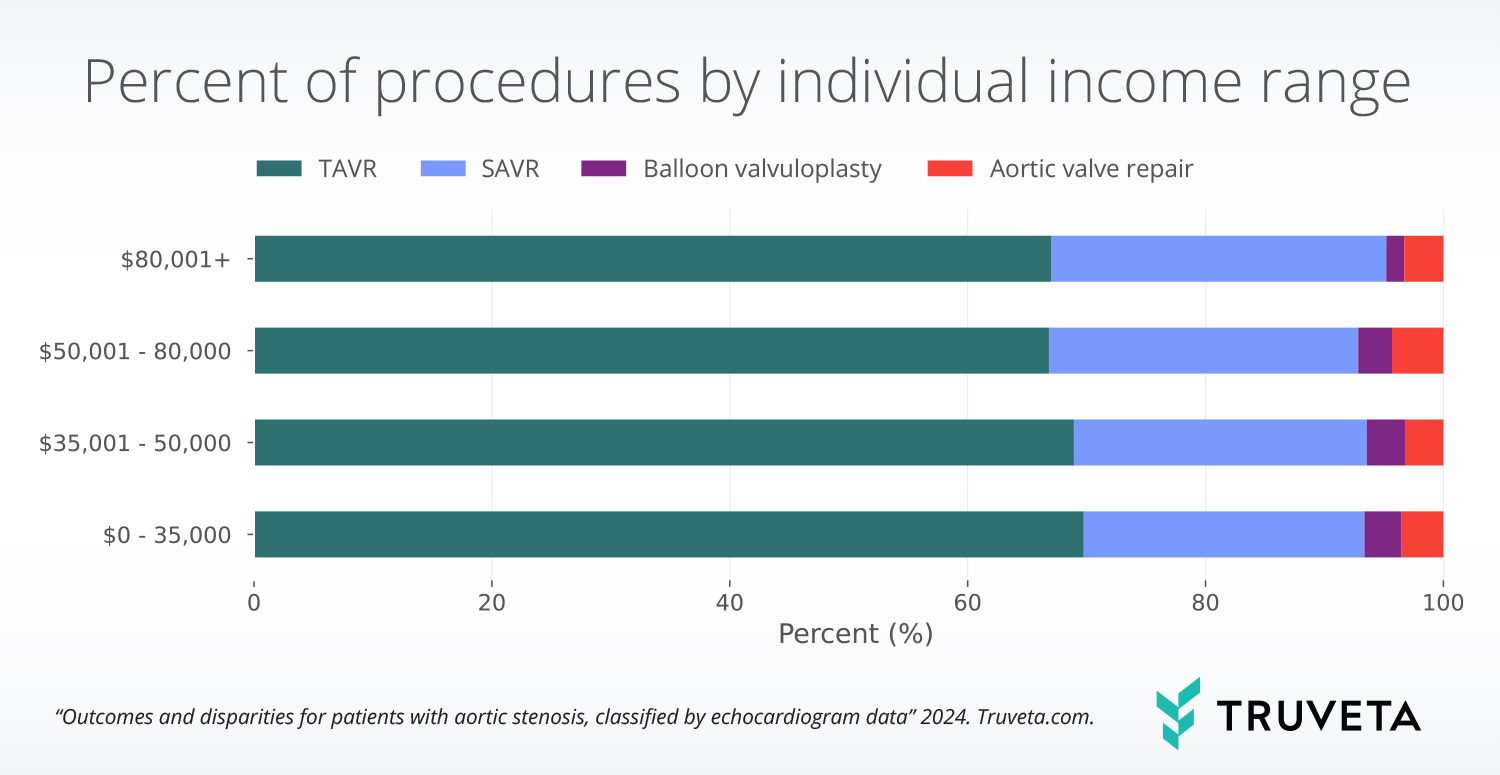
There was also small variation in procedure rates by family support (measured by the distance to closest relative). People whose family lived more than 100 miles away received a slightly lower percentage of TAVR procedures and a slightly higher rate of balloon valvuloplasty procedures and aortic valve repairs.
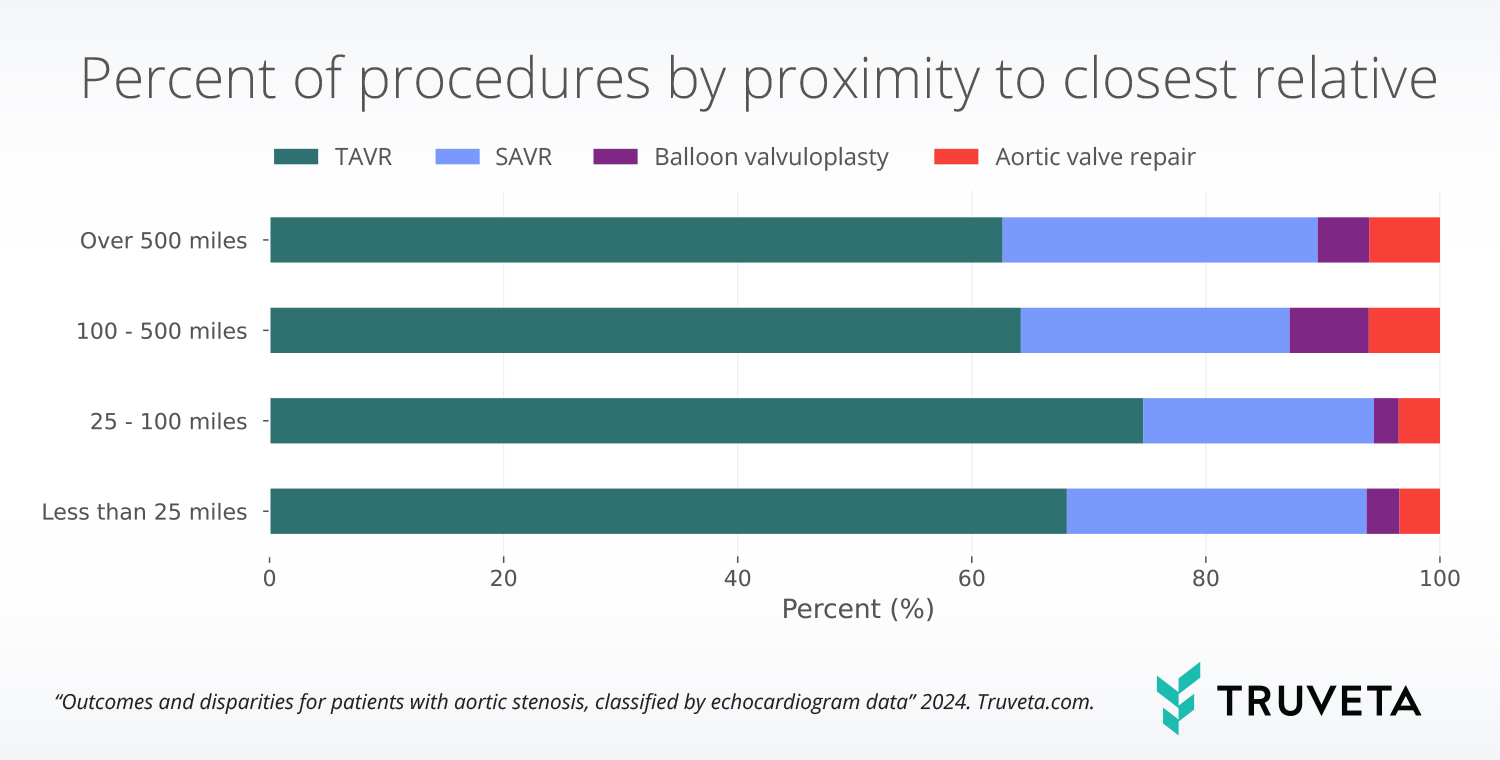
When a person’s location could be classified, patients who resided in urban areas had higher rates of TAVR (68.2%) compared to patients who resided in rural areas (65.3%).
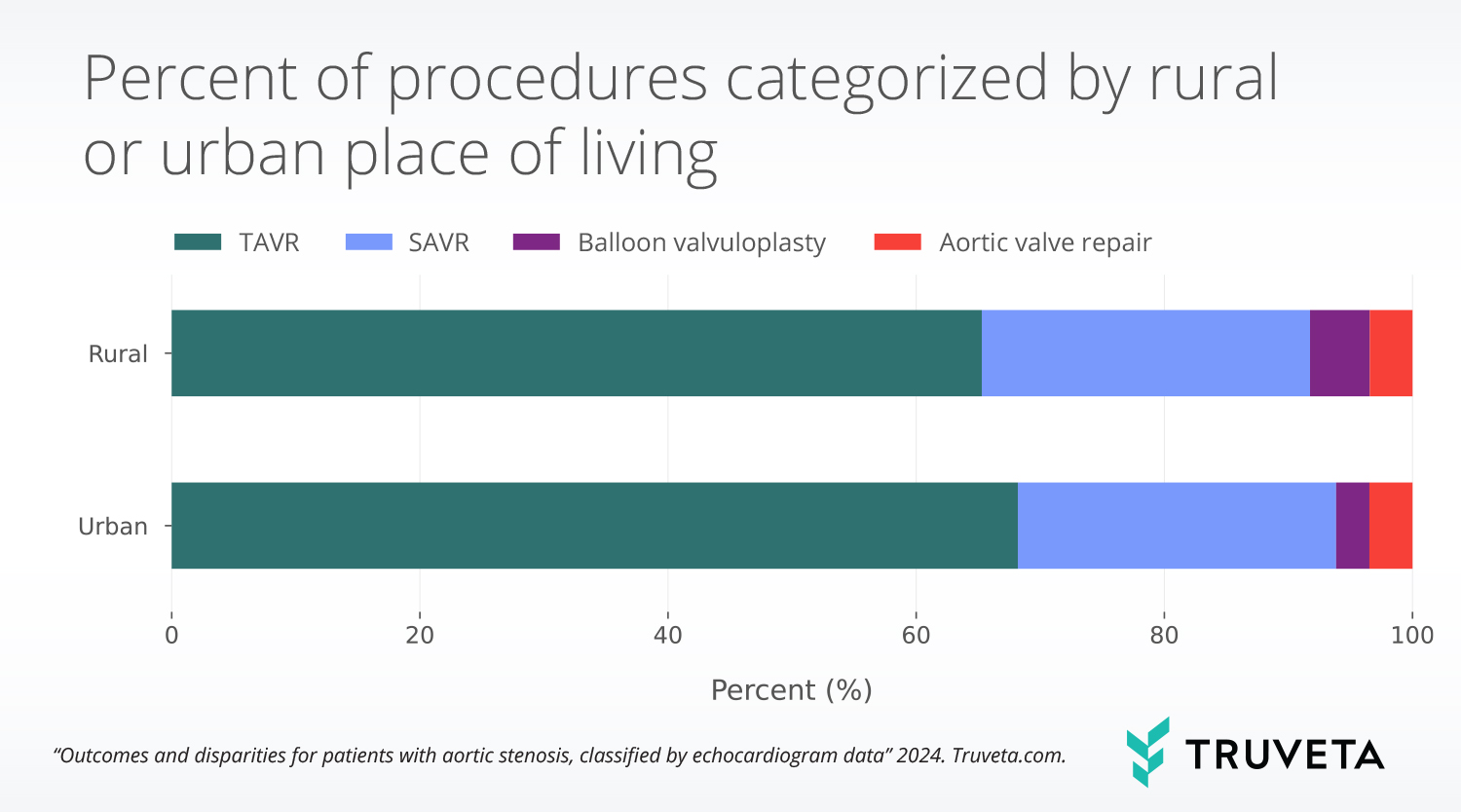
Outcomes
For all subsequent analyses, outcomes are grouped into three categories of aortic stenosis severity: 1) mild or moderate progressive aortic stenosis, 2) asymptomatic severe or very severe aortic stenosis (referred to as asymptomatic severe), and 3) symptomatic aortic stenosis (inclusive of all symptomatic categories).
The majority of the population had mild or moderate aortic stenosis (69.8%). Smaller percentages had asymptomatic severe (16.4%) or symptomatic severe (13.8%) aortic stenosis.
Time to procedure
For people who received a TAVR procedure, we found the time between the first echocardiogram and procedure increased with increasing disease severity. 89.3% of patients with a TAVR procedure following diagnosis of symptomatic severe aortic stenosis received the procedure within 1 year. The average time was 0.4±0.9 years. This decreased for people with asymptomatic severe aortic stenosis; 80.9% received the procedure within 1 year. The average time between echocardiogram and TAVR was 0.9 ± 1.9 years.
Finally, for people with mild or moderate aortic stenosis and a TAVR procedure, only 27.5% received the procedure within one year. Procedures for this group averaged at 3.6 ± 3.2 years between echocardiogram and TAVR.
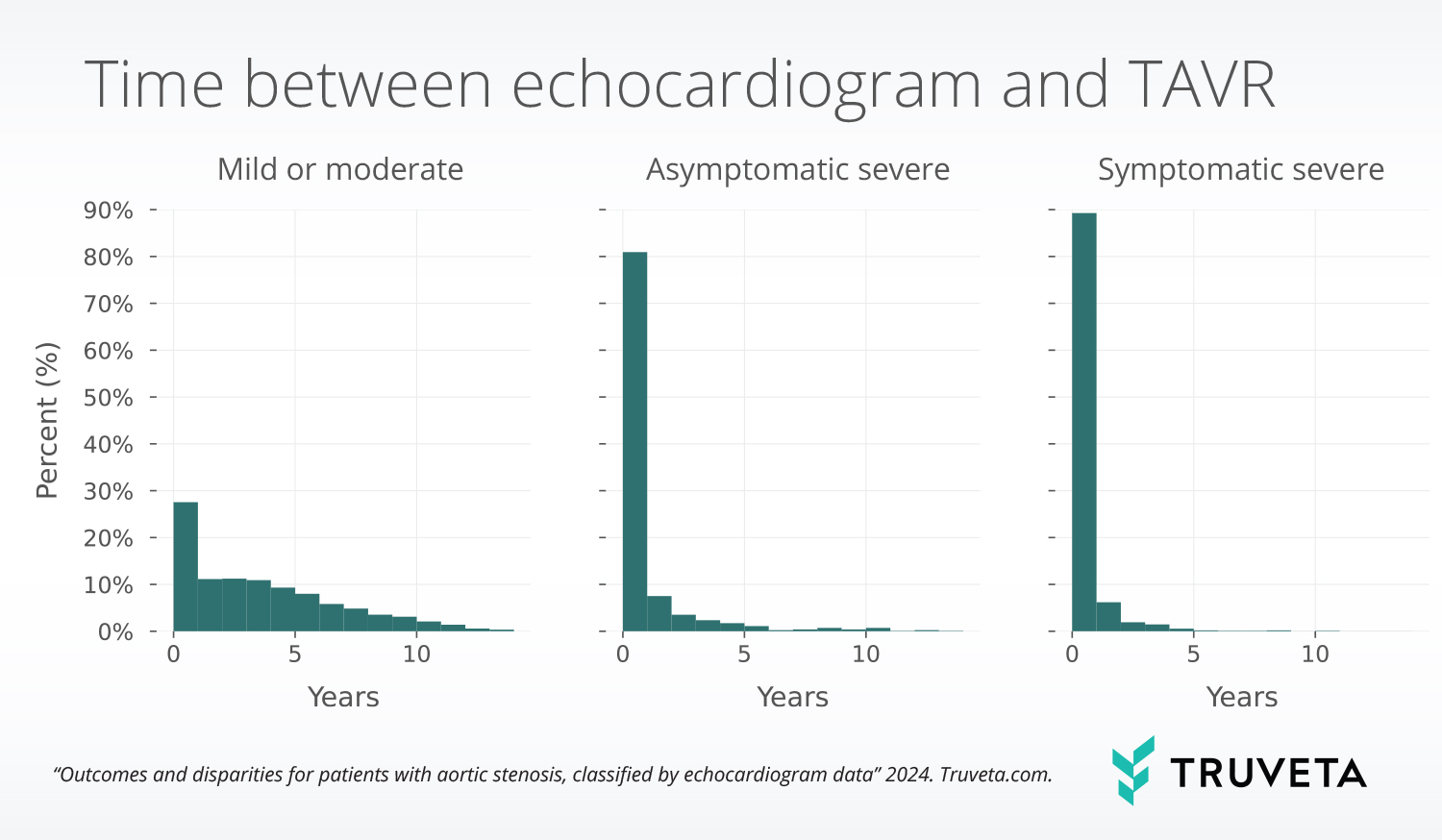
Similar trends were observed across all procedures studied.
Time to TAVR by SDOH
For people with symptomatic severe aortic stenosis who received a TAVR procedure, there was an inverse relationship between the time to procedure and individual income (people with higher individual incomes had, on average, a shorter time to procedure).
The plots below show the mean value (dot) and the standard deviation (lines extending from the dots). This gives an idea about the distribution of the data.
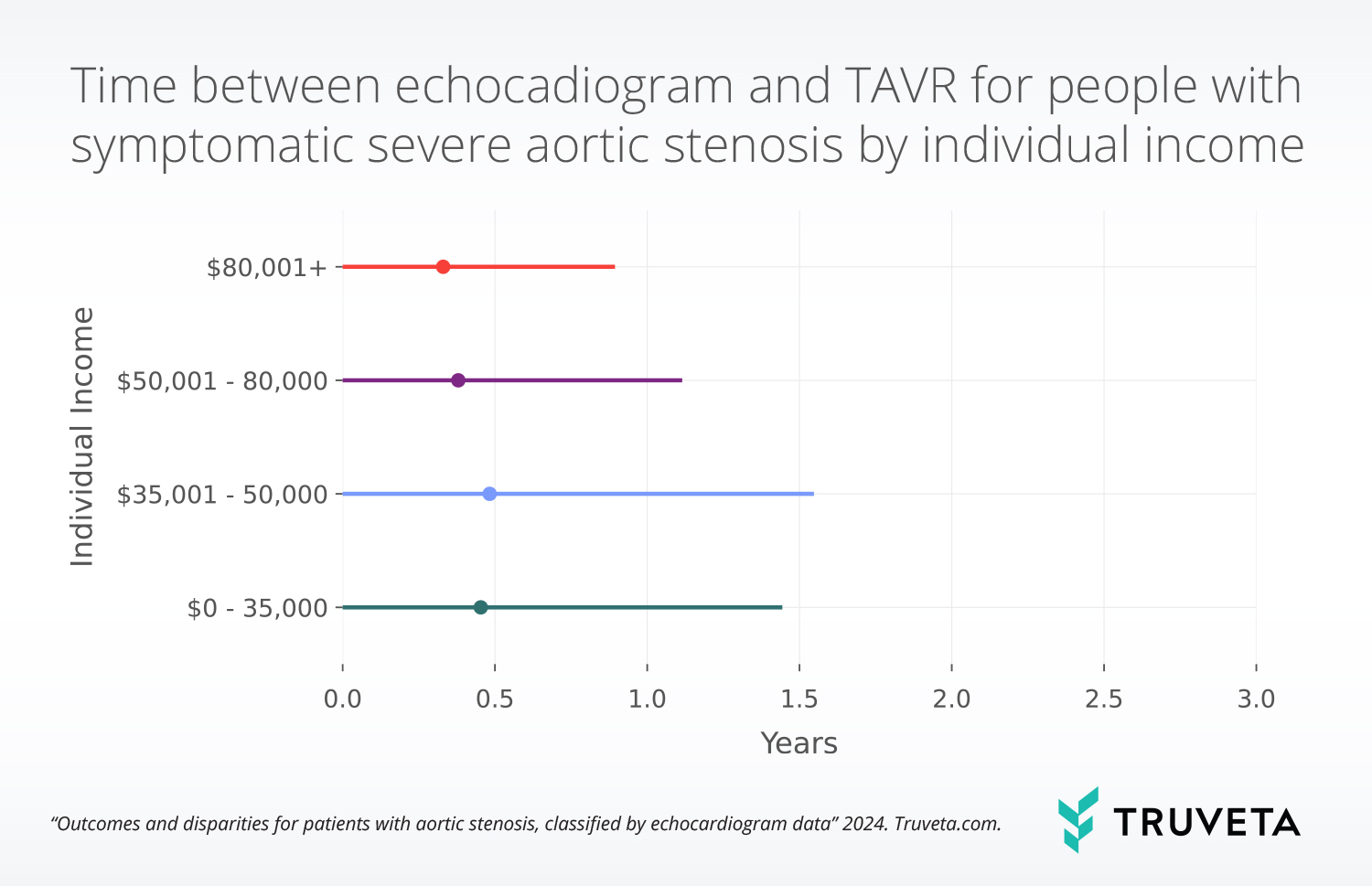
People with symptomatic severe aortic stenosis who lived in an urban area, on average receive a TAVR within 0.4±0.9 years, while people who lived in a rural area on average receive one 2.4 months later (0.6±1.0 years between echocardiogram and TAVR).
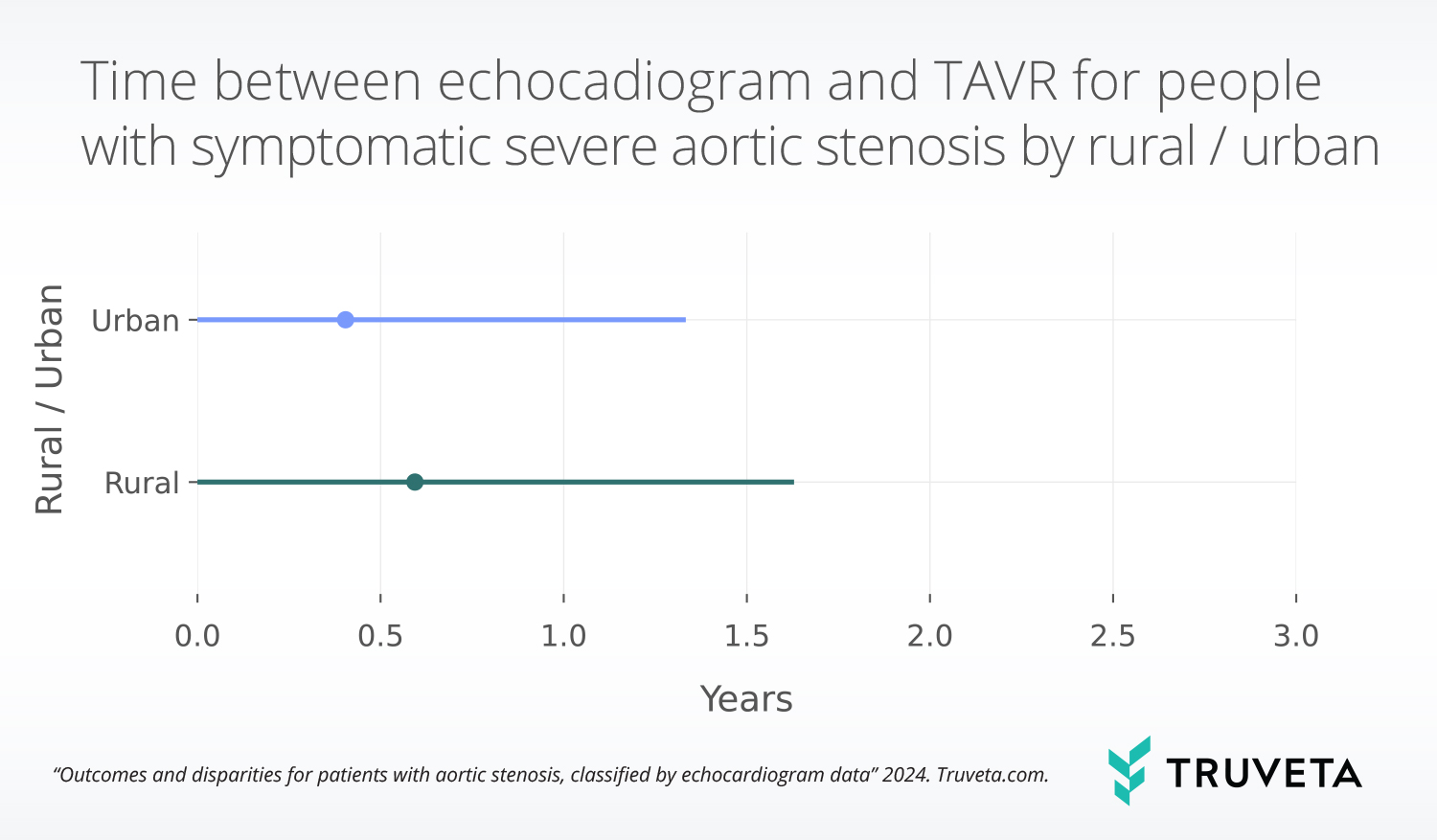
For people who lived over 25 miles from their closest relative, increased distance from a family member (less familial support) positively correlated with increased time between the first symptomatic severe aortic stenosis echocardiogram and time to TAVR.
Increased time to TAVR existed for the population who lived within 25 miles of their nearest family member (0.4 ± 1.0 years), compared to the population who lives within 25-100 miles of a family member (0.1 ± 0.2 years).
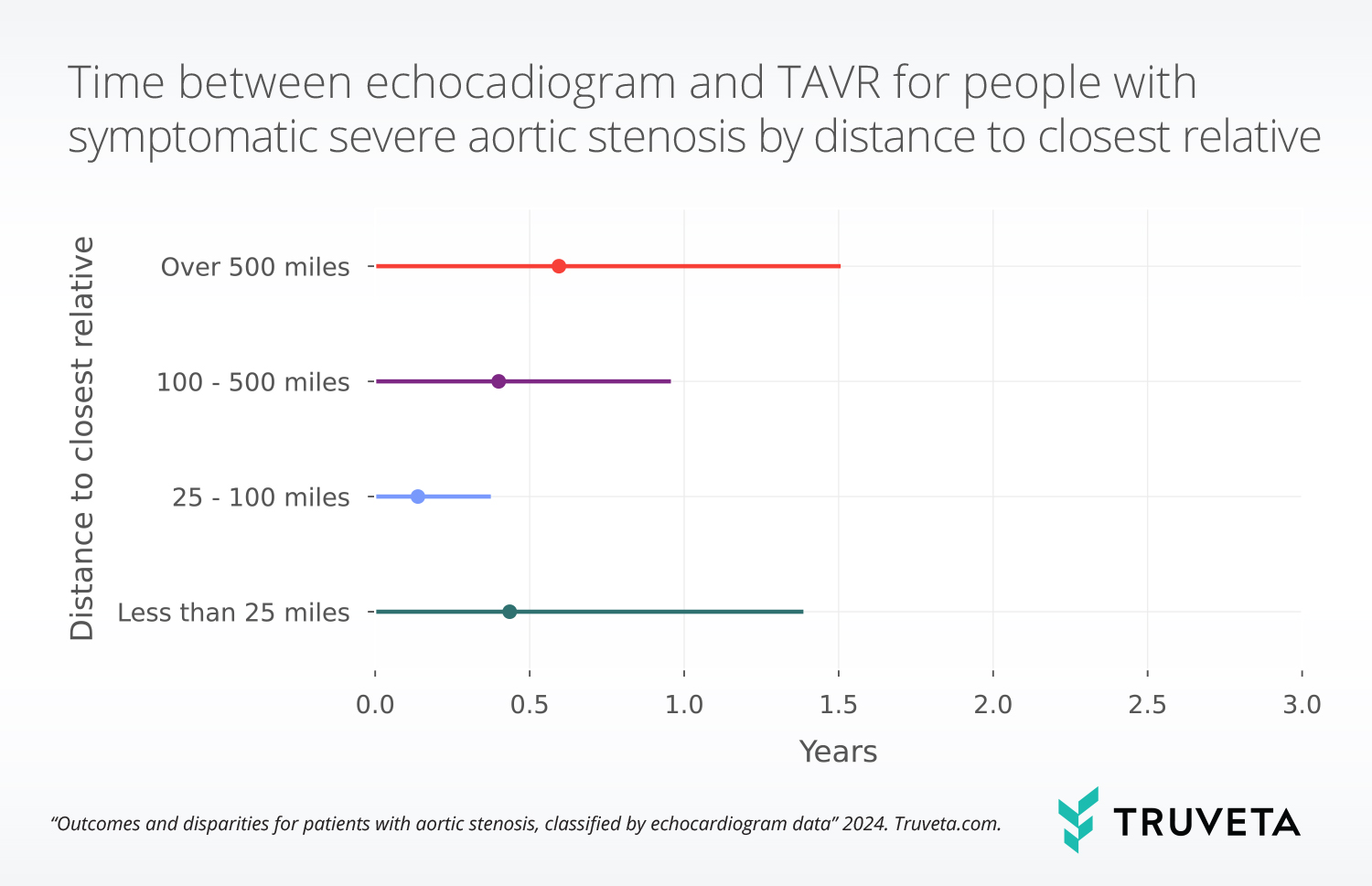
Discussion
In this study we aimed to use the extracted and structured echocardiogram data provided within Truveta Data to understand time to procedure and potential disparities for people with different aortic stenosis severities. The data extracted from echocardiogram notes, in combination with condition data, allow us to classify aortic stenosis severity. In addition, combining with procedure data, we can classify how long patients waited before receiving a procedure. Finally, by including demographic and SDOH data, we are able to understand potential disparities in time between first possible diagnosis and subsequent procedures.
This study demonstrates that TAVR procedures are more likely to be performed in patients over 65 years of age, while SAVRs are more common for younger patients, consistent with estimates of operative risk and recommendations in these populations (Otto et al., 2021). Older populations are at higher risk for aortic stenosis and for poor outcomes following surgical procedures (Di Eusanio et al., 2011) and previous studies have shown SAVR procedures are not offered to older adults as often, likely for these reasons (Bouma et al., 1999; Iung et al., 2005). The transcutaneous approach (TAVR) is typically safer in older patients than the surgical approach (SAVR), so TAVR is more frequently recommended over SAVR in older patients (Otto et al., 2021). Another interesting finding in this study, is the increased rate of balloon valvuloplasty in patients residing in rural areas, as well as the longer period between echocardiogram and TAVR in this group. This highlights future research hypotheses; rural care facilities may be less likely to offer more complex procedures such as TAVR, SAVR, or aortic valve repair. In these situations, a balloon valvuloplasty may be offered as a bridge to provide extra time before proceeding with a TAVR. In the future, we could look to understand if people who live in rural settings receive a balloon valvuloplasty with a subsequent TAVR at higher rates than people who reside in a urban setting.
Disparities in both treatment rates and subsequent outcomes have been previously reported for TAVR procedures (Ahmed et al., 2023; Bevan et al., 2019). In this study we found potential disparities in the time between echocardiogram and TAVR for people with symptomatic severe aortic stenosis for various income rates; however, no statistics were implemented in this study to test for significant differences. There may be correlation between lower individual income and increased age, which may contribute to the higher rate of TAVR in people with lower incomes (who may also be older). There are large distributions within the data presented here, representing the variation which occurs in real-world clinical care. To further the analysis here, models which combine the factors here and incorporate additional clinical factors, such as comorbidity status should be used to account for and understand potential differences between populations studied.
There are a few limitations with this study. First, we did not include people who did not have evidence of TAVR, SAVR, aortic valve repair, or aortic balloon valvuloplasty. There may be additional or different disparities within a population who did not receive any procedures. Second, as common with any study of EHR data, any procedures or echocardiograms that happened outside a Truveta member health system would not be captured within this analysis. Additionally, we grouped aortic stenosis severities together into three main severity groups. Additional work should be completed to understand the variation within each of these groups.
Beyond the specific findings in this study, our work underscores the growing utility of leveraging electronic health record (EHR), enhanced with notes, and linked with SDOH data to between understand where disparities may exist, specifically in cardiovascular care. The identification of disparities in the pathway from diagnosis to treatment for aortic stenosis, as exemplified in this research, highlights the need for continued research into causes and additional outcomes. In an era where data-driven insights play a pivotal role in shaping healthcare policies and practices, data such as these can be utilized to pave the way for more inclusive and patient-centered healthcare strategies.
You can view the study in its entirety in Truveta Studio.
Citations
Ahmad, Y., Howard, J. P., Seligman, H., Arnold, A. D., Madhavan, M. V., Forrest, J. K., Geirsson, A., Mack, M. J., Lansky, A. J., & Leon, M. B. (2022). Early Surgery for Patients With Asymptomatic Severe Aortic Stenosis: A Meta-Analysis of Randomized Controlled Trials. Journal of the Society for Cardiovascular Angiography & Interventions, 1(4), 100383. https://doi.org/10.1016/j.jscai.2022.100383
Ahmed, Y., van Bakel, P. A. J., Hou, H., Sukul, D., Likosky, D. S., van Herwaarden, J. A., Watkins, D. C., Ailawadi, G., Patel, H. J., Thompson, M. P., & for the Structural Heart and Aortic Diseases Outcomes Research Workgroup Investigators. (2023). Racial and ethnic disparities in diagnosis, management and outcomes of aortic stenosis in the Medicare population. PLOS ONE, 18(4), e0281811. https://doi.org/10.1371/journal.pone.0281811
Bartus, K., Sadowski, J., Litwinowicz, R., Filip, G., Jasinski, M., Deja, M., Kusmierczyk, M., Pawlak, S., Jemielity, M., Jagielak, D., Hendzel, P., Suwalski, P., Tobota, Z., Maruszewski, B., & Kapelak, B. (2019). Changing trends in aortic valve procedures over the past ten years—From mechanical prosthesis via stented bioprosthesis to TAVI procedures—Analysis of 50,846 aortic valve cases based on a Polish National Cardiac Surgery Database. Journal of Thoracic Disease, 11(6), 2340–2349. https://doi.org/10.21037/jtd.2019.06.04
Bevan, G. H., Zidar, D. A., Josephson, R. A., & Al-Kindi, S. G. (2019). Mortality Due to Aortic Stenosis in the United States, 2008-2017. JAMA, 321(22), 2236. https://doi.org/10.1001/jama.2019.6292
Bouma, B. J., Van Den Brink, R. B. A., Van Der Meulen, J. H. P., Verheul, H. A., Cheriex, E. C., Hamer, H. P. M., Dekker, E., Lie, K. I., & Tijssen, J. G. P. (1999). To operate or not on elderly patients with aortic stenosis: The decision and its consequences. Heart, 82(2), 143–148. https://doi.org/10.1136/hrt.82.2.143
Di Eusanio, M., Fortuna, D., De Palma, R., Dell’Amore, A., Lamarra, M., Contini, G. A., Gherli, T., Gabbieri, D., Ghidoni, I., Cristell, D., Zussa, C., Pigini, F., Pugliese, P., Pacini, D., & Di Bartolomeo, R. (2011). Aortic valve replacement: Results and predictors of mortality from a contemporary series of 2256 patients. The Journal of Thoracic and Cardiovascular Surgery, 141(4), 940–947. https://doi.org/10.1016/j.jtcvs.2010.05.044
Franke, K. B., Bhatia, D., Roberts-Thomson, R. L., & Psaltis, P. J. (2023). Aortic valve replacement reduces mortality in moderate aortic stenosis: A systematic review and meta-analysis. Journal of Geriatric Cardiology, 20(1), 61–67. https://doi.org/10.26599/1671-5411.2023.01.003
Gleeson, J. R. (2018, March 28). Weighing TAVR vs. SAVR for Aortic Stenosis Treatment. Michigan Medicine. https://www.michiganmedicine.org/health-lab/weighing-tavr-vs-savr-aortic-stenosis-treatment
HRSA Health Resources & Services Administration. (2024, January). Defining Rural Population. https://www.hrsa.gov/rural-health/about-us/what-is-rural
Iung, B., Cachier, A., Baron, G., Messika-Zeitoun, D., Delahaye, F., Tornos, P., Gohlke-Bärwolf, C., Boersma, E., Ravaud, P., & Vahanian, A. (2005). Decision-making in elderly patients with severe aortic stenosis: Why are so many denied surgery? European Heart Journal, 26(24), 2714–2720. https://doi.org/10.1093/eurheartj/ehi471
Otto, C. M. (2006). Valvular Aortic Stenosis. Journal of the American College of Cardiology, 47(11), 2141–2151. https://doi.org/10.1016/j.jacc.2006.03.002
Otto, C. M., Nishimura, R. A., Bonow, R. O., Carabello, B. A., Erwin, J. P., Gentile, F., Jneid, H., Krieger, E. V., Mack, M., McLeod, C., O’Gara, P. T., Rigolin, V. H., Sundt, T. M., Thompson, A., & Toly, C. (2021). 2020 ACC/AHA Guideline for the Management of Patients With Valvular Heart Disease: A Report of the American College of Cardiology/American Heart Association Joint Committee on Clinical Practice Guidelines. Circulation, 143(5), e72–e227. https://doi.org/10.1161/CIR.0000000000000923

